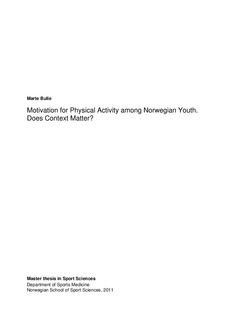| dc.contributor.author | Bulie, Marte | |
| dc.date.accessioned | 2017-04-18T09:14:25Z | |
| dc.date.available | 2017-04-18T09:14:25Z | |
| dc.date.issued | 2011 | |
| dc.identifier.uri | http://hdl.handle.net/11250/2437560 | |
| dc.description | Masteroppgave - Norges idrettshøgskole, 2011 | nb_NO |
| dc.description.abstract | Aims: The aim of the present study was to identify the proportional distribution of a sample of adolescents in four different activity groups and to examine the effect of activity contexts (organized sport vs. unorganized physical activity contexts) on the adolescents’ motivation for participation. Methods: A total of 2,116 adolescents (1,020 males and 1,085 females), mean age 15.3 years, completed a self-report questionnaire during school time. The Situational Motivation Scale (SIMS) was used to evaluate the adolescents’ situational motivation in the two different activity contexts. Results: 1- The relative number of adolescents who reported involvement in organized sport only and involvement in both organized sport and unorganized physical activity decreased with age, and the relative number of non-active adolescents and adolescents participating in unorganized physical activity only increased with age. 2- Adolescents involved in both types of activity contexts (Org&Unorg) expressed a more self-determined motivational profile when operating in organized contexts compared to unorganized physical activity contexts. 3- Adolescents who participated in the unorganized physical activity context only did not express a more self-determined motivational profile compared to adolescents who participated in the organized sport context only. 4- Adolescents reporting from lifestyle oriented unorganized contexts expressed a more self-determined motivational profile compared to adolescents who reported from health oriented or sport performance oriented unorganized contexts. Discussion: The contradiction between the high self-determination scores and the decrease in organized sport participation is discussed; and the paper concludes that comparing organized sport vs. unorganized physical activity contexts on motivation for participation in physical activity is an over simplification which could potentially lead to invalid results. The results give further rise to the importance of recognizing more lifestyle oriented unorganized physical activity contexts. | nb_NO |
| dc.language.iso | eng | nb_NO |
| dc.subject | masteroppgaver | nb_NO |
| dc.subject | nih | nb_NO |
| dc.subject | fysisk aktivitet | nb_NO |
| dc.subject | motivasjon | nb_NO |
| dc.subject | ungdom | nb_NO |
| dc.subject | artikler | nb_NO |
| dc.title | Motivation for physical activity among Norwegian youth : does context matter? | nb_NO |
| dc.type | Master thesis | nb_NO |
| dc.description.localcode | Seksjon for idrettsmedisinske fag / Department of Sports Medicine | nb_NO |
